New Insight on the Stratigraphic-Diffusive Gas Hydrate System since the Pleistocene in the Dongsha Area of the Northeastern South China Sea
Abstract
:1. Introduction
2. Regional Geological Setting and Slope Stratigraphic Model
2.1. Geologic Background
2.2. Simplified Deposition Model
3. Gauging Geological Process
3.1. Total Deposition and Microbial Production
3.2. Sedimentary Properties
3.3. Flow Properties
3.4. Geothermal Field
3.5. Microbial Gas Generation
3.6. Pore Salinity
3.7. MH Reaction
3.8. Physical Stoichiometric Model
4. Results
4.1. MH Performance during Deposition
4.2. Simultaneous Decomposition and Formation
4.3. Comparison of Different Geological Cases
5. Discussion
5.1. Different Accumulation Geological Timescale
5.2. Seawater Depth Restriction
5.3. Gas Source Influence
6. Conclusions
Author Contributions
Funding
Institutional Review Board Statement
Informed Consent Statement
Data Availability Statement
Acknowledgments
Conflicts of Interest
List of Notations
| Cd | integrated drag coefficient |
| CK-C | factor |
| Cwa | methane concentration |
| Da(Θ) | methane diffusion coefficient, m2/s |
| Dw(Θ) | water diffusivity in sediment, m2/s |
| ds | particle diameter, m |
| e | void ratio = φ/(1 − φ) |
| fi | local fugacity, subscript i = eq (equilibrium state), MPa |
| g | gravity = 9.8 N/kg |
| kri | relative hydraulic conductivity, subscript i = w (water), and a (gas), and has lateral (x), and vertical (z) two directions |
| ks0,i | intrinsic hydraulic conductivity, subscript i = x (lateral), and z (vertical), m/s; when no i, it represents whole conductivity |
| ksh | intrinsic hydraulic conductivity with hydrate existence, m/s |
| Ls | accumulation thickness, m |
| Lse | layer depth, m |
| Lw | seawater depth, m |
| Mi | molar mass, subscript i = a (methane), and w (water), kg/mol |
| m | parameter related to SWCC curve = 1 − 1/ϖ |
| P | vertical pressure, MPa |
| nominal resource, mol/m | |
| qa | total other methane input source, kg·m−2·ka−1 |
| qao | in situ microbial methane generation rate, kg·m−3·ka−1 |
| qw | pore water drainage, kg·m−2·ka−1 |
| qwa | dissolved methane, kg·m−2·ka−1 |
| ri | reaction rate, subscript i = a (methane), h (hydrate) and w (water), mol·m−3·ka−1 |
| pore size of porous media (in angstroms) | |
| Si | phase saturation, subscript i = a (gas), h (hydrate), and w (water) |
| Sarea | area of study slope, m2 |
| Ssp | specific surface = 6/ds = 3/rs, m−1 |
| Td | geothermal gradient, °C/m |
| Teq | equilibrium temperature, °C |
| Tsi | temperature, subscript i = b (seafloor), and e (sediment), °C |
| t | time, ka |
| ui | pressure, subscript i = a (gas), and w (water), kPa |
| usc | matric potential, kPa |
| vs | practical deposition rate, cm/ka |
| vsr | referential deposition rate, cm/ka |
| Xwis | pore salinity, subscript i = 0 (initial state) |
| xc | fraction of clay particle volume |
| z | vertical position, m |
| zBSRZ | depth to base of SRZ, m |
| α | parameter related to gas inlet pressure, kPa−1 |
| αBSRZ | metabolizable organic carbon at SRZ base, dry weight% |
| β | attenuation coefficient |
| ζ0 | kinetic coefficient, mol·m−3·MPa−1·ka−1 |
| ηp | coefficient = 0.8 |
| Θ | relating water content |
| θi | real-time volume content, subscript i = h (hydrate), a (air), and w (water) |
| θir | residual content, subscript i = a (air), and w (water) |
| θws | saturated water content |
| ƙ | particle compressibility modulus |
| λ | reaction rate constant of microbial methanogenesis, s−1 |
| ϖ | parameter related to pore size distribution of sediment |
| ρi | density, subscript i = w (water), h (hydrate), and s (grain), kg/m3 |
| σc | static consolidation stress, MPa |
| σc0 | static preconsolidation stress associated with a reference porosity, MPa |
| average porosity without presence of hydrates | |
| ϕ0,i | porosity, subscript i = 0 (seafloor), z (depth) and ∞ (infinite); when no i, it represents initial state |
| ϕh,z | porosity at depth z in presence of hydrates |
| ω | sedimentary factor |
References
- Qin, X.; Lu, J.; Lu, H.; Qiu, H.; Liang, J.; Kang, D.; Zhan, L.; Lu, H.; Kuang, Z. Coexistence of natural gas hydrate, free gas and water in the gas hydrate system in the Shenhu Area, South China Sea. China Geol. 2020, 2, 210–220. [Google Scholar]
- Ye, J.; Qin, X.; Xie, W.; Lu, H.; Ma, B.; Qiu, H.; Liang, J.; Lu, J.; Kuang, Z.; Lu, C.; et al. The second natural hydrate production test in the South China Sea. China Geol. 2020, 2, 197–209. [Google Scholar]
- Archer, D.E.; Buffett, B.A. A two-dimensional model for the methane cycle in a sedimentary accretionary wedge. Biogeosciences 2012, 9, 3323–3336. [Google Scholar] [CrossRef] [Green Version]
- Collett, T.; Bahk, J.; Baker, R.; Boswell, R.; Divins, D.; Frye, M.; Goldberg, D.; Husebo, J.; Koh, C.; Malone, M.; et al. Methane hydrates in nature-current knowledge and challenges. J. Chem. Eng. Data 2015, 60, 319–329. [Google Scholar] [CrossRef]
- Koh, C.A.; Sum, A.K.; Sloan, E.D. State of the art: Natural gas hydrates as a natural resource. J. Nat. Gas Sci. Eng. 2012, 8, 132–138. [Google Scholar] [CrossRef]
- Boswell, R.; Collett, T.S. Current perspectives on gas hydrate resources. Energy Environ. Sci. 2011, 4, 1206–1215. [Google Scholar] [CrossRef]
- Pang, X.; Chen, Z.; Jia, C.; Wang, E.; Shi, H.; Wu, Z.; Hu, T.; Liu, K.; Zhao, Z.; Pang, B.; et al. Evaluation and re-understanding of the global natural gas hydrate resources. Pet. Sci. 2021, 18, 323–338. [Google Scholar] [CrossRef]
- Archer, D.; Buffett, B.; Brovkin, V. Ocean methane hydrates as a slow tipping point in the global carbon cycle. Proc. Natl. Acad. Sci. USA 2009, 106, 20596–20601. [Google Scholar] [CrossRef] [Green Version]
- Berndt, C.; Feseker, T.; Treude, T.; Krastel, S.; Lirbetrau, V.; Niemann, H.; Bertics, V.J.; Dumke, I.; Dünnbier, K.; Ferrré, B.; et al. Temporal constraints on hydrate-controlled methane seepage off Svalbard. Science 2014, 343, 284–287. [Google Scholar] [CrossRef] [Green Version]
- Dickens, G.R. Down the rabbit hole: Toward appropriate discussion of methane release from gas hydrate systems during the Paleocene-Eocene thermal maximum and other past hyperthermal events. Clim. Past 2011, 7, 831–846. [Google Scholar] [CrossRef] [Green Version]
- Ruppel, C.D.; Kessler, J.D. The interaction of climate change and methane hydrates. Rev. Geophys. 2017, 55, 126–168. [Google Scholar] [CrossRef]
- Bonan, G.B.; Doney, S.C. Climate, ecosystems, and planetary futures: The challenge to predict life in Earth system models. Science 2018, 359, 533. [Google Scholar] [CrossRef] [PubMed] [Green Version]
- Feng, D.; Qiu, J.; Hu, Y.; Peckmann, J.; Guan, H.; Tong, H.; Chen, C.; Chen, J.; Gong, S.; Li, N.; et al. Cold seep systems in the South China Sea: An overview. J. Asian Earth Sci. 2018, 168, 3–16. [Google Scholar] [CrossRef]
- Karstens, J.; Haflidason, H.; Becker, L.W.M.; Berndt, C.; Rüpke, L.; Planke, S.; Liebetrau, V.; Schmidt, M.; Mienert, J. Glacigenic sedimentation pulses triggered post-glacial gas hydrate dissociation. Nat. Commun. 2018, 9, 635. [Google Scholar] [CrossRef]
- Suess, E. Marine cold seeps and their manifestations: Geological control, biogeochemical criteria and environmental conditions. Int. J. Earth Sci. 2014, 103, 1889–1916. [Google Scholar] [CrossRef]
- Hu, G.; Bu, Q.; Lyu, W.; Wang, J.; Chen, J.; Li, Q.; Gong, J.; Sun, J.; We, N. A comparative study on natural gas hydrate accumulation models at active and passive continental margins. Nat. Gas Ind. B 2021, 8, 115–127. [Google Scholar] [CrossRef]
- Straume, E.O.; Gaina, C.; Medvedev, S.; Hochmuth, K.; Gohl, K.; Whittaker, J.M.; Fattah, R.A.; Doornenbal, J.C.; Hopper, J.R. GlobSed: Updated total sediment thickness in the world’s oceans. Geochem. Geophys. Geosyst. 2019, 20, 1756–1772. [Google Scholar] [CrossRef]
- Chatterjee, S.; Bhatnagar, G.; Dugan, B.; Dickens, G.R.; Chapman, W.G.; Hirasaki, G.J. The impact of lithologic heterogeneity and focused fluid flow upon gas hydrate distribution in marine sediment. J. Geophys. Res. Solid Earth 2014, 119, 6705–6732. [Google Scholar] [CrossRef] [Green Version]
- Cook, A.E.; Malinverno, A. Short migration of methane into a gas hydrate-bearing sand layer at Walker Ridge, Gulf of Mexico. Geochem. Geophys. Geosyst. 2013, 14, 283–291. [Google Scholar] [CrossRef]
- Wei, L.; Cook, A.; Daigle, H.; Malinverno, A.; Nole, M.; You, K. Factors controlling short-range methane migration of gas hydrate accumulations in thin coarse-grained layers. Geochem. Geophys. Geosyst. 2019, 20, 3985–4000. [Google Scholar] [CrossRef]
- You, K.; Flemings, P.B.; Malinverno, A.; Collett, T.S.; Darnell, K. Mechanisms of methane hydrate formation in geological systems. Rev. Geophys. 2019, 5, 1146–1196. [Google Scholar] [CrossRef]
- Yang, S.; Liang, J.; Lu, J.; Qu, C.; Liu, B. New understandings on characteristic and controlling factors of gas hydrate reservoirs in Shenhu area on northern slope of South China Sea. Earth Sci. Front. 2017, 24, 1–14. (In Chinese) [Google Scholar]
- Sun, M.; Ren, J.; Zhong, G.; Yi, H. Fold deformations of mesozoic strata and their genetic mechanism in Southwestern Dongsha waters of northern South China Sea. Geol. Rev. 2018, 64, 828–842. (In Chinese) [Google Scholar]
- Wang, X.; Cai, F.; Sun, Z.; Li, Q.; Li, A.; Yan, G.; Sun, Y.; Luo, D.; Dong, F. Sedimentary evolution and geological signification of the Dongsha submarine canyon in the northern South China Sea. Earth Sci. 2021, 46, 1023–1037. (In Chinese) [Google Scholar]
- Nole, M.; Daigle, H.; Cook, A.E.; Malinverno, A. Short-range, overpressure-driven methane migration in coarse-grained gas hydrate reservoirs. Geophys. Res. Lett. 2016, 43, 9500–9508. [Google Scholar] [CrossRef]
- Stolper, D.A.; Lawson, M.; Davis, C.L.; Ferreira, A.A.; Neto, E.V.S.; Ellis, G.S.; Lewan, M.D.; Martini, A.M.; Tang, Y.; Schoell, M.; et al. Formation temperatures of thermogenic and biogenic methane. Science 2014, 344, 1500–1503. [Google Scholar] [CrossRef]
- Tinna, J.; David, A. A stochastic, Lagrangian model of sinking biogenic aggregates in the ocean (SLAMS 1.0): Model formulation, validation and sensitivity. Geosci. Model Dev. 2016, 9, 1455–1476. [Google Scholar]
- Li, L.; Lei, X.; Zhang, X.; Sha, Z. Gas hydrate and associated free gas in the Dongsha Area of northern South China Sea. Mar. Pet. Geol. 2013, 39, 92–101. [Google Scholar] [CrossRef]
- Li, L.; Liu, H.; Zhang, X.; Lei, H.; Sha, Z. BSRs, estimated heat flow, hydrate-related gas volume and their implications for methane seepage and gas hydrate in the Dongsha region, northern South China Sea. Mar. Pet. Geol. 2015, 67, 785–794. [Google Scholar] [CrossRef] [Green Version]
- Jin, J.; Wang, X.; He, M.; Li, J.; Yan, C.; Li, Y.; Zhou, J.; Qian, J. Downward shift of gas hydrate stability zone due to seafloor erosion in the eastern Dongsha Island, South China Sea. J. Oceanol. Limnol. 2020, 38, 1188–1200. [Google Scholar] [CrossRef]
- Han, W.; Chen, L.; Liu, C. Distribution and characteristics of gas chimneys in the passive margin offshore SW Taiwan. Mar. Geophys. Res. 2021, 42, 25. [Google Scholar] [CrossRef]
- Li, J.; Li, L.; Bai, S.; Ta, K.; Xu, H.; Chen, S.; Pan, J.; Li, M.; Du, M.; Peng, X. New insight into the biogeochemical cycling of methane, S and Fe above the Sulfate-Methane Transition Zone in methane hydrate-bearing sediments: A case study in the Dongsha area, South China Sea. Deep-Sea Res. Part I 2019, 145, 97–108. [Google Scholar] [CrossRef]
- Zhang, B.; Pan, M.; Wu, D.; Wu, N. Distribution and isotopic composition of foraminifera at cold-seep Site 973-4 in the Dongsha area, northeastern South China Sea. J. Asian Earth Sci. 2018, 168, 145–154. [Google Scholar] [CrossRef]
- Bai, C.; Zhang, G.; Lu, J.; Liang, J.; Yang, Z.; Yan, W.; Zhu, D.; Tian, Y. Deep-water sediment waves as a special gas hydrate reservoirs in the Northeastern South China Sea. Mar. Pet. Geol. 2019, 101, 476–485. [Google Scholar] [CrossRef]
- Sha, Z.; Liang, J.; Zhang, G.; Yang, S.; Lu, J.; Zhang, Z.; McConnell, D.R.; Humphret, G. A seepage gas hydrate system in northern South China Sea: Seismic and well log interpretations. Mar. Geol. 2015, 366, 69–78. [Google Scholar] [CrossRef]
- Zhang, G.; Liang, J.; Lu, J.; Yang, S.; Zhang, M.; Holland, M.; Schultheiss, P.; Su, X.; Sha, Z.; Xu, H.; et al. Geological features, controlling factors and potential prospects of the gas hydrate occurrence in the east part of the Pearl River Mouth Basin, South China Sea. Mar. Pet. Geol. 2015, 67, 356–367. [Google Scholar] [CrossRef]
- Guan, J.; Cong, X.; Archer, D.; Wan, L.; Liang, D. Spatio-temporal evolution of stratigraphic-diffusive methane hydrate reservoirs since the Pliocene along Shenhu continental slope, northern South China Sea. Mar. Pet. Geol. 2021, 125, 104864. [Google Scholar] [CrossRef]
- Fu, C.; Yu, X.; Fan, X.; He, Y.; Liang, J.; Li, S. Classification of mass-transport complexes and distribution of gas hydrate-bearing sediments in the northeastern continental slope of the South China Sea. Front. Earth Sci. 2020, 14, 25–36. [Google Scholar] [CrossRef]
- Gong, C.; Wang, Y.; Xu, S.; Pickering, K.T.; Peng, X.; Li, W.; Yan, Q. The northeastern South China Sea margin created by the combined action of down-slope and along-slope processes: Processes, products and implications for exploration and paleoceanography. Mar. Pet. Geol. 2015, 64, 233–249. [Google Scholar] [CrossRef]
- Li, W.; Alves, T.M.; Wu, S.; Rebesco, M.; Zhao, F.; Mi, L.; Ma, B. A giant, submarine creep zone as a precursor of large-scale slope instability offshore the Dongsha Islands (South China Sea). Earth Planet. Sci. Lett. 2016, 451, 272–284. [Google Scholar] [CrossRef]
- Liu, B.; Chen, J.; Pinheiro, L.M.; Yang, L.; Liu, S.; Guan, Y.; Song, H.; Wu, N.; Xu, H.; Yang, R. An insight into shallow gas hydrates in the Dongsha area, South China Sea. Acta Oceanol. Sin. 2021, 40, 136–146. [Google Scholar] [CrossRef]
- Wang, J.; Wu, S.; Sun, J.; Feng, W.; Li, Q. Influence of seafloor topography on gas hydrate occurrence across a submarine canyon-incised continental slope in the northern margin of the South China Sea. Mar. Pet. Geol. 2021, 133, 105279. [Google Scholar] [CrossRef]
- Chuang, P.; Yang, T.F.; Wallmann, K.; Matsumuto, R.; Hu, C.; Chen, H.; Lin, S.; Sun, C.; Li, H.; Wang, Y.; et al. Carbon isotope exchange during anaerobic oxidation of methane (AOM) in sediments of the northeastern South China Sea. Geochim. Cosmochim. Acta 2019, 246, 138–155. [Google Scholar] [CrossRef]
- Ye, H.; Yang, T.; Zhu, G.; Jiang, S.; Wu, L. Pore water geochemistry in shallow sediments from the northeastern continental slope of the South China Sea. Mar. Pet. Geol. 2016, 75, 68–82. [Google Scholar] [CrossRef]
- Zhong, G.; Liang, J.; Guo, Y.; Kuang, Z.; Su, P.; Lin, L. Integrated core-log facies analysis and depositional model of the gas hydrate-bearing sediments in the northeastern continental slope, South China Sea. Mar. Pet. Geol. 2017, 86, 1159–1172. [Google Scholar] [CrossRef]
- Cui, H.; Su, X.; Liang, J.; Chen, F.; Holland, M.; Yang, S.; Zhang, G.; Su, P.; Dong, H. Microbial diversity in fracture and pore filling gas hydrate-bearing sediments at Site GMGS2-16 in the Pearl River Mouth Basin, the South China Sea. Mar. Geol. 2020, 427, 106264. [Google Scholar] [CrossRef]
- Wang, B.; Lei, H.; Huang, F.; Kong, Y.; Pan, F.; Cheng, W.; Chen, Y.; Guo, L. Effect of sea-level change on deep-sea sedimentary records in the northeastern South China Sea over the past 42 kyr. Geofluids 2020, 2020, 814545. [Google Scholar] [CrossRef]
- Li, W.; Alves, T.M.; Wu, S.; Volker, D.; Zhao, F.; Mi, L.; Kopf, A. Recurrent slope failure and submarine channel incision as key factors controlling reservoir potential in the South China Sea (Qiongdongnan Basin, South Hainan Island). Mar. Pet. Geol. 2015, 64, 17–30. [Google Scholar] [CrossRef]
- Klauda, J.B.; Sandler, S.I. Global distribution of methane hydrate in ocean sediment. Energy Fuels 2005, 19, 459–470. [Google Scholar] [CrossRef]
- Nikolinakou, M.A.; Heidari, M.; Flemings, P.B.; Hudec, M.R. Geomechanical modeling of pore pressure in evolving salt systems. Mar. Pet. Geol. 2018, 93, 272–286. [Google Scholar] [CrossRef]
- Waal, H.D.; Smits, R.M.M. Prediction of reservoir compaction and surface subsidence: Field application of a new model. SPE Form. Eval. 1988, 3, 347–356. [Google Scholar] [CrossRef]
- Elhakim, A.F. Estimation of soil permeability. Alex. Eng. J. 2016, 55, 2631–2638. [Google Scholar] [CrossRef] [Green Version]
- Steiakakis, E.; Gamvroudis, C.; Alevizos, G. Kozeny-Carman equation and hydraulic conductivity of compacted clayey soils. Geomaterials 2012, 2, 37–41. [Google Scholar] [CrossRef] [Green Version]
- Cassiani, G.; Brovelli, A.; Hueckel, T. A strain-rate-dependent modified Cam-Clay model for the simulation of soil/rock compaction. Geomech. Energy Environ. 2017, 11, 42–51. [Google Scholar] [CrossRef]
- Fredlund, D.G.; Xing, A.; Huang, S. Predicting the permeability function for unsaturated soils using the soil-water characteristic curve. Can. Geotech. J. 1994, 31, 533–546. [Google Scholar] [CrossRef]
- Malinverno, A. Marine gas hydrates in thin sand layers that soak up microbial methane. Earth Planet. Sci. Lett. 2010, 292, 399–408. [Google Scholar] [CrossRef]
- Archer, D.E.; Buffett, B.A.; McGuire, P.C. A two-dimensional model of the passive coastal margin deep sedimentary carbon and methane cycles. Biogeosciences 2012, 9, 2859–2878. [Google Scholar] [CrossRef] [Green Version]
- Burwicz, E.B.; Rupke, L.H.; Wallmann, K. Estimation of the global amount of submarine gas hydrates formed via microbial methane formation based on numerical reaction-transport modeling and a novel parameterization of Holocene sedimentation. Geochim. Cosmochim. Acta 2011, 75, 4562–4576. [Google Scholar] [CrossRef] [Green Version]
- Colin, F.; Ker, S.; Riboulot, V.; Sultan, N. Irregular BSR: Evidence of an ongoing reequilibrium of a gas hydrate system. Geophys. Res. Lett. 2020, 47, e2020GL089906. [Google Scholar] [CrossRef]
- Eymold, W.K.; Frederick, J.M.; Nole, M.; Phrampus, B.J.; Wood, W.T. Prediction of gas hydrate formation at Blake Ridge using machine learning and probabilistic reservoir simulation. Geochem. Geophys. Geosyst. 2021, 22, e2020GC009574. [Google Scholar] [CrossRef]
- Guan, J.; Wan, L.; Liang, D. Gauging formation dynamics of structural-seepage methane hydrate reservoirs in Shenhu area of northern South China Sea: Impact of seafloor sedimentation and assessment of controlling factors. Mar. Pet. Geol. 2019, 107, 185–197. [Google Scholar] [CrossRef]
- Zheng, Z.; Cao, Y.; Xu, W.; Chen, D. A numerical model to estimate the effects of variable sedimentation rates on methane hydrate formation-Application to the ODP Site 997 on Blake ridge, southeastern North American continental margin. J. Geophys. Res. Solid Earth 2020, 125, e2019JB018851. [Google Scholar] [CrossRef]
- Farthing, M.; Ogden, F.L. Numerical solution of Richard’s equation: A review of advances and challenges. Soil Sci. Soc. Am. J. 2017, 81, 1257–1269. [Google Scholar] [CrossRef] [Green Version]
- Freeze, R.A. Three-dimensional, transient, saturated-unsaturated flow in a groundwater basin. Water Resour. Res. 1971, 7, 347–366. [Google Scholar] [CrossRef] [Green Version]
- Hopmans, J.W.; Schukking, H.; Torfs, P.J.J.F. Two-dimensional steady state unsaturated water flow in heterogeneous soils with autocorrelated soil hydraulic properties. Water Resour. Res. 1988, 24, 200–2017. [Google Scholar] [CrossRef]
- Murphy, Z.W.; DiCarlo, D.A.; Flemings, P.B.; Daigle, H. Hydrate is a nonwetting phase in porous media. Geophys. Res. Lett. 2020, 47, e2020GL089289. [Google Scholar] [CrossRef]
- Nielsen, D.R.; Genuchten, M.T.; Biggar, J.W. Water flow and solute transport processes in the unsaturated zone. Water Resour. Res. 1986, 22, 89S–108S. [Google Scholar] [CrossRef]
- Liang, Q.; Zhao, J.; Xia, Z.; Yang, S.; Kang, J.; Lin, J.; Lei, Z.; Deng, Y.; Teng, D. Distribution characteristics and influential factors of dissolved methane in the sea water above gas hydrate area at the northern slope of South China Sea. Earth Sci. Front. 2017, 24, 89–101. (In Chinese) [Google Scholar] [CrossRef]
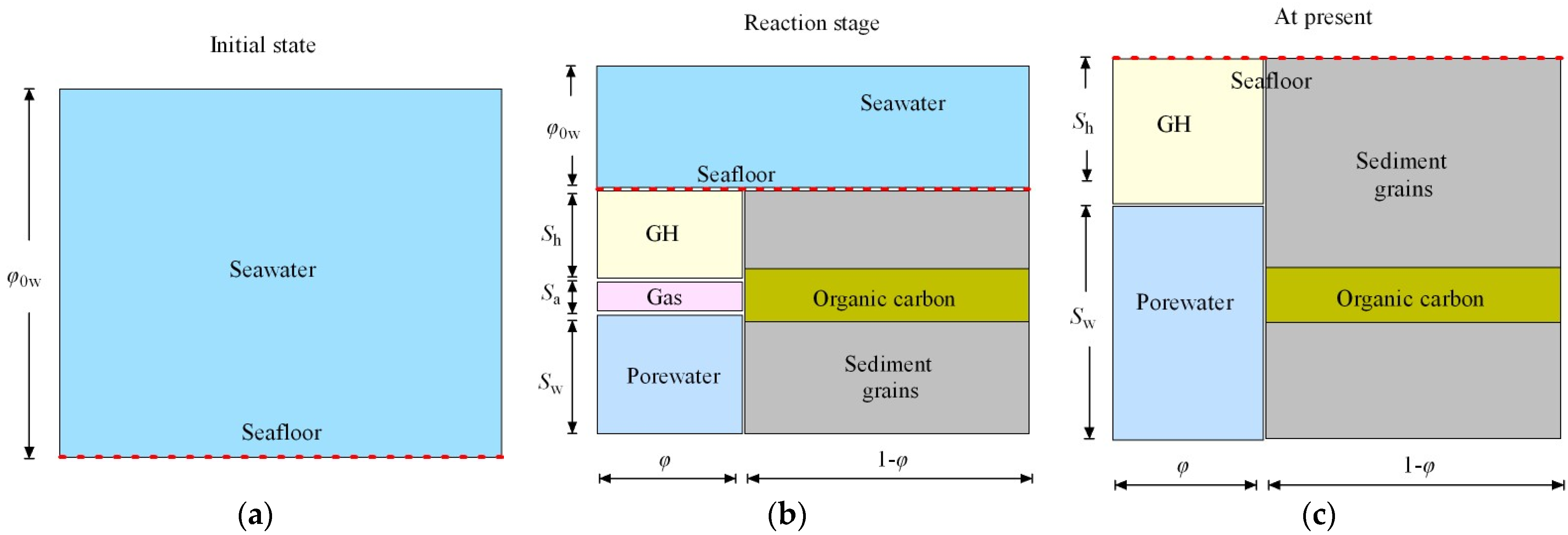
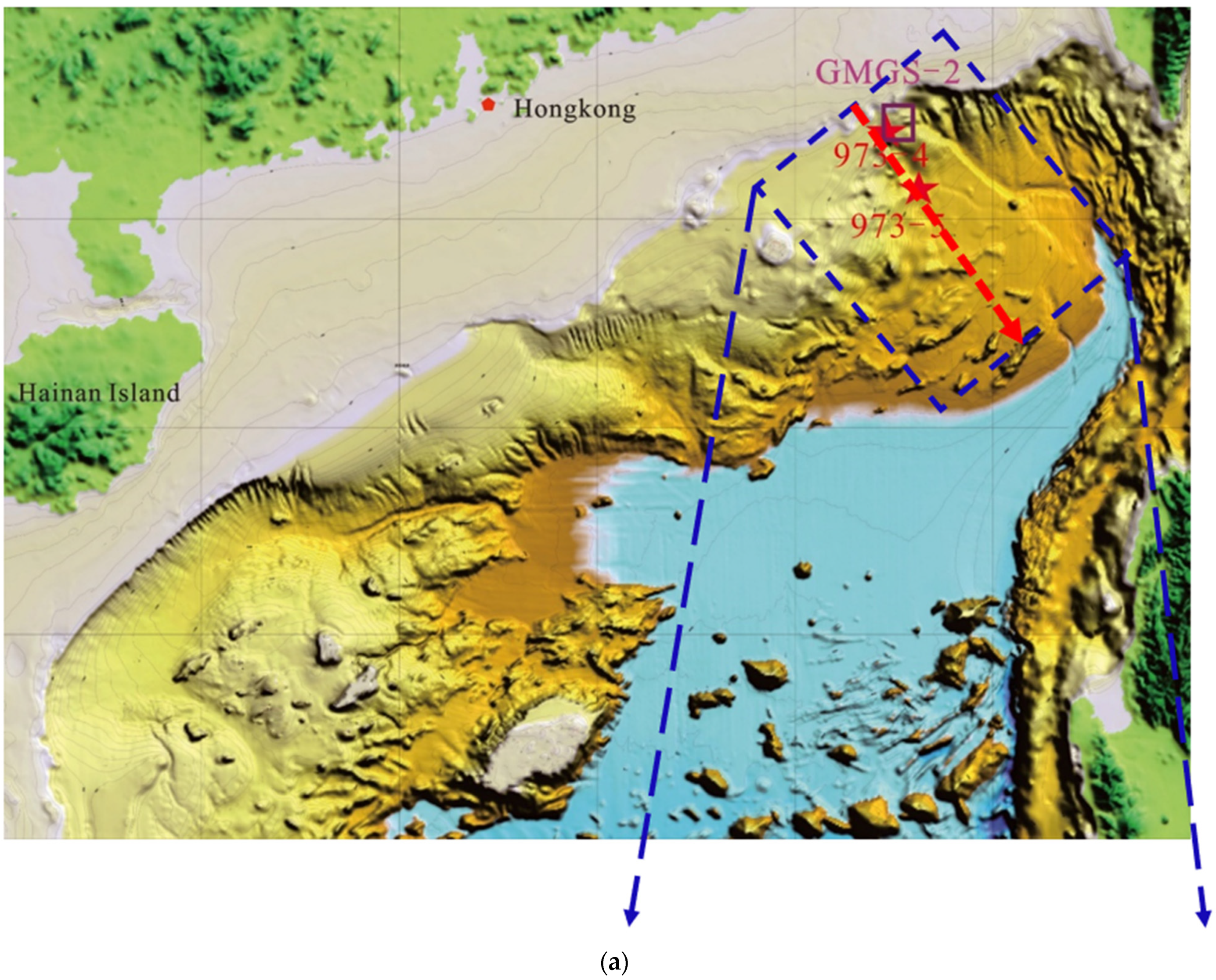

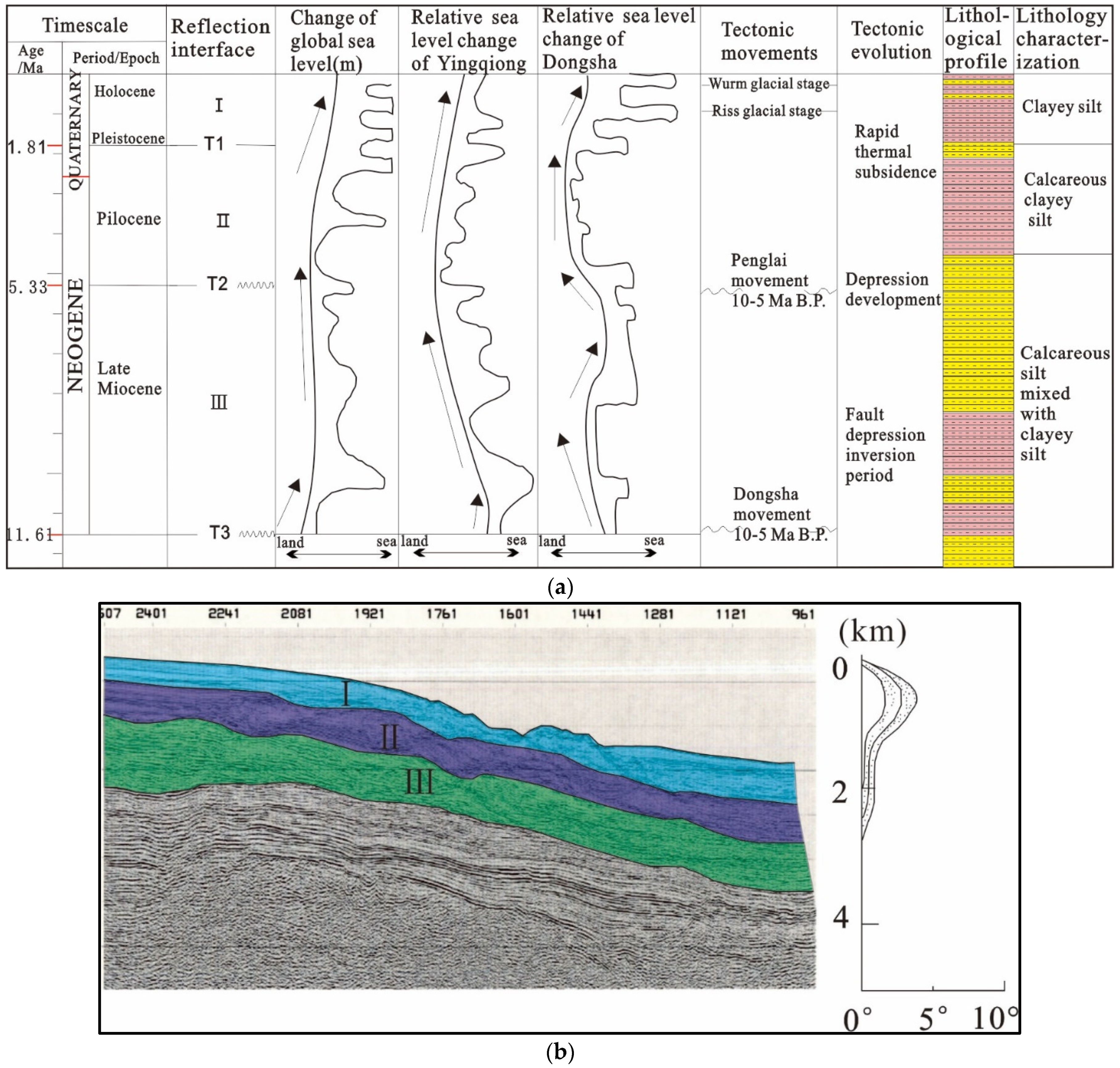
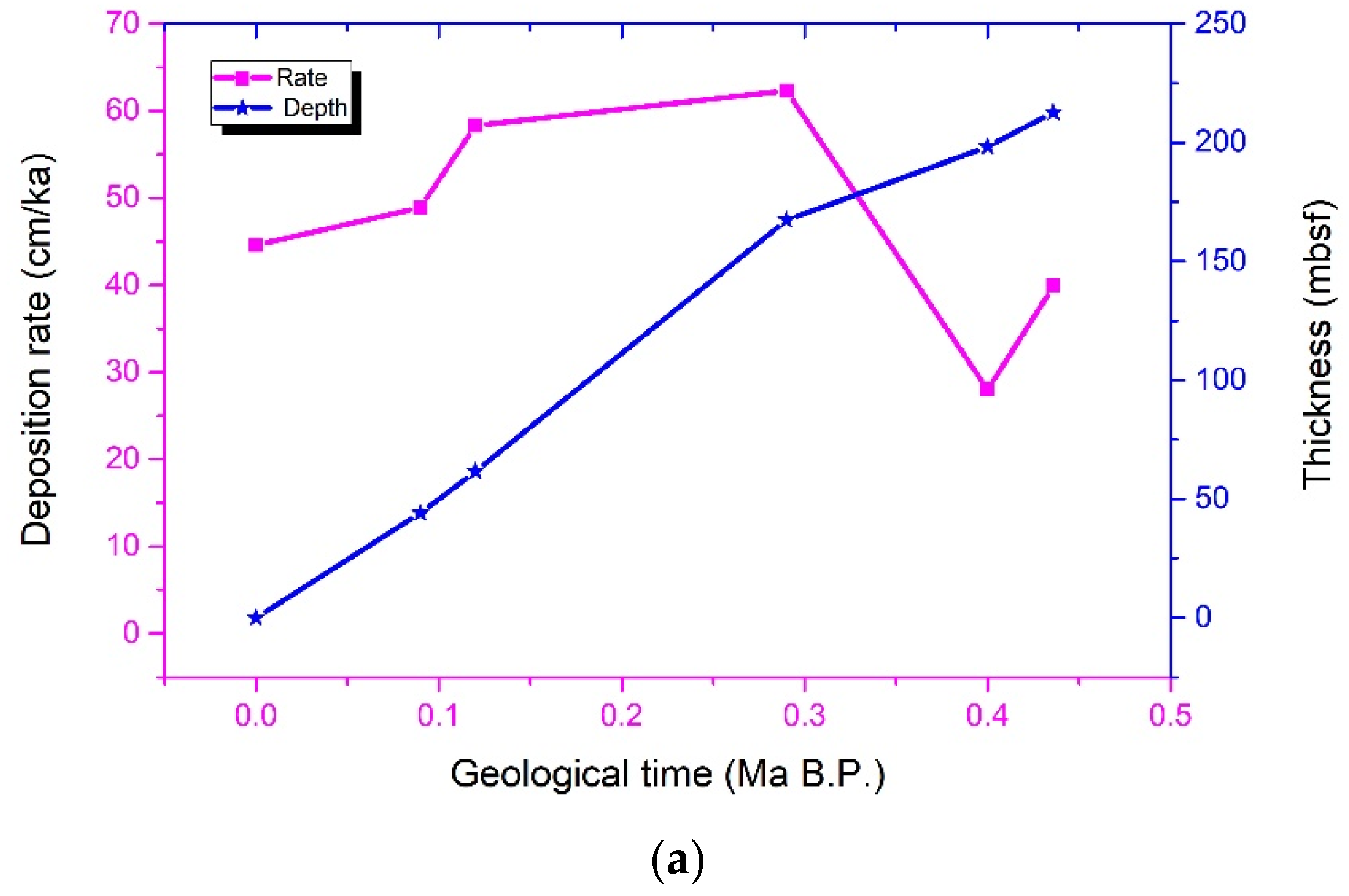
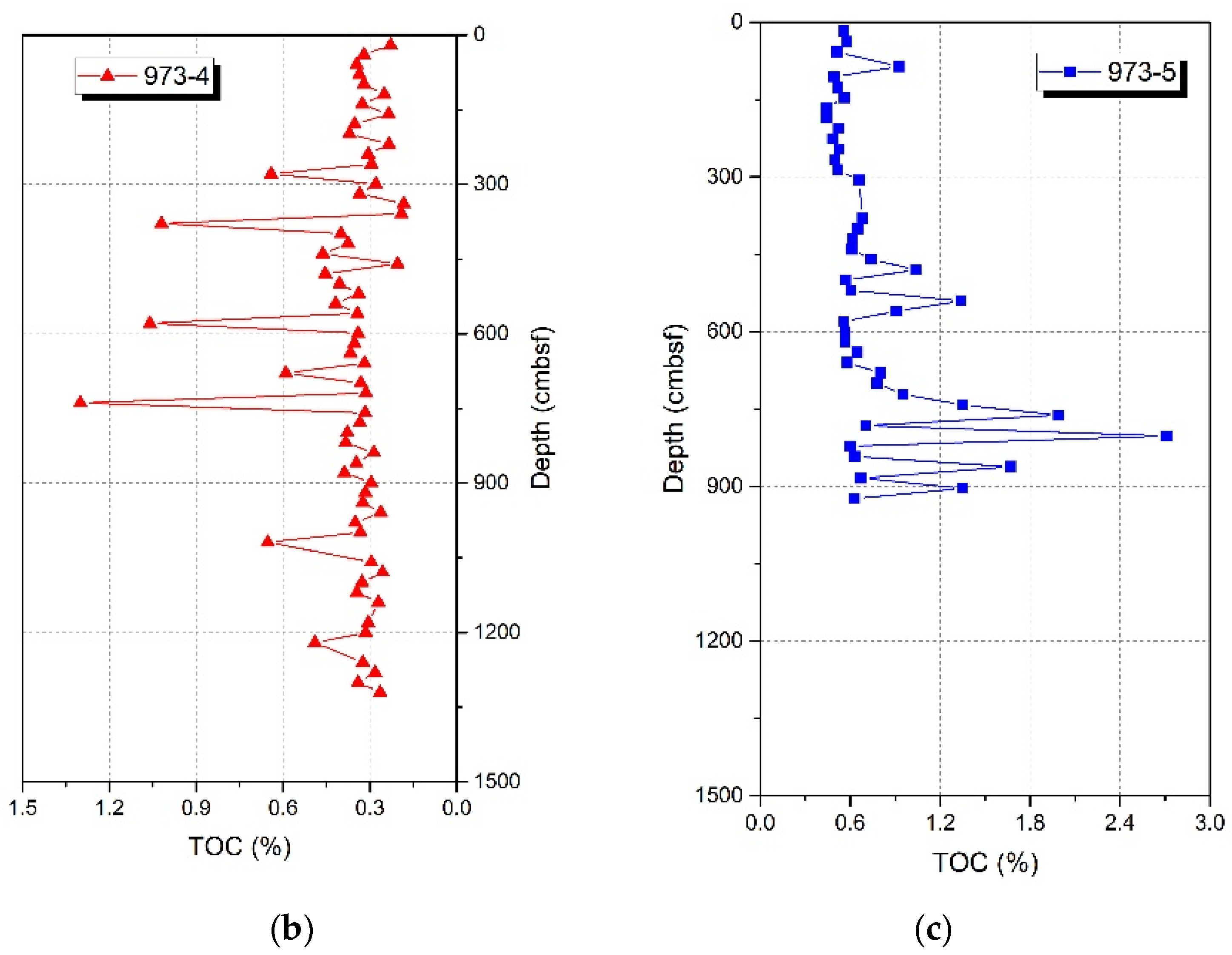
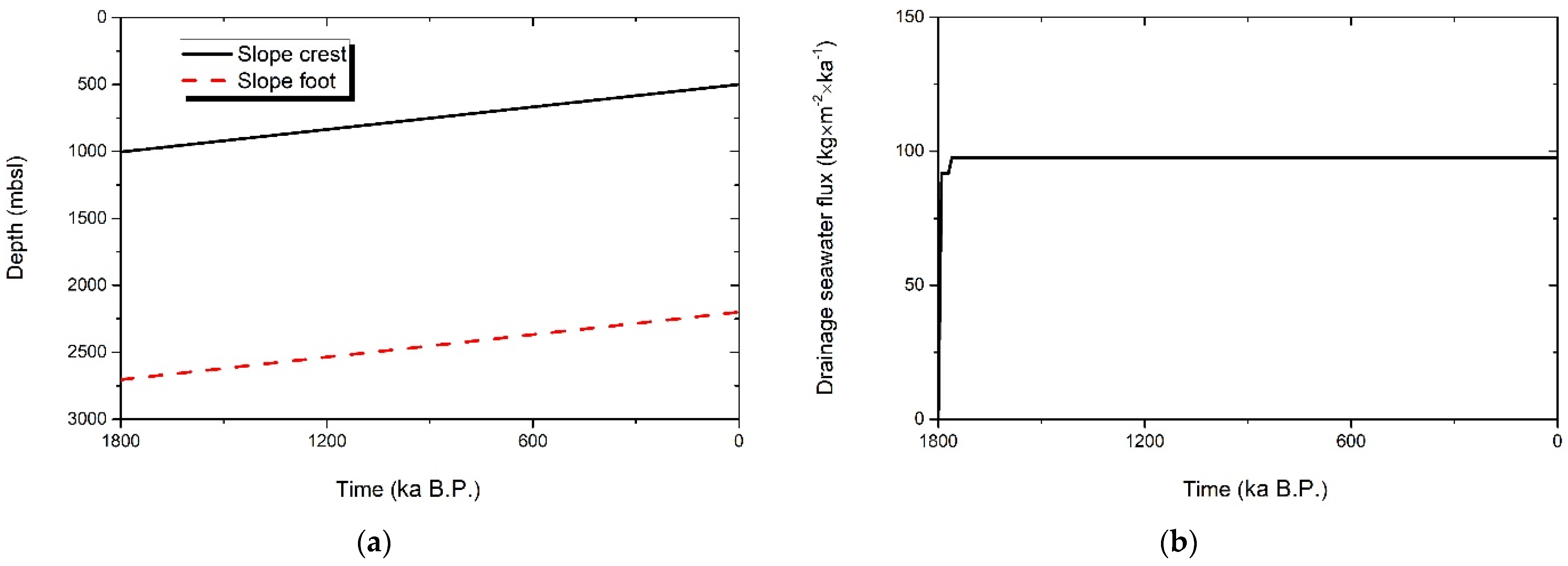



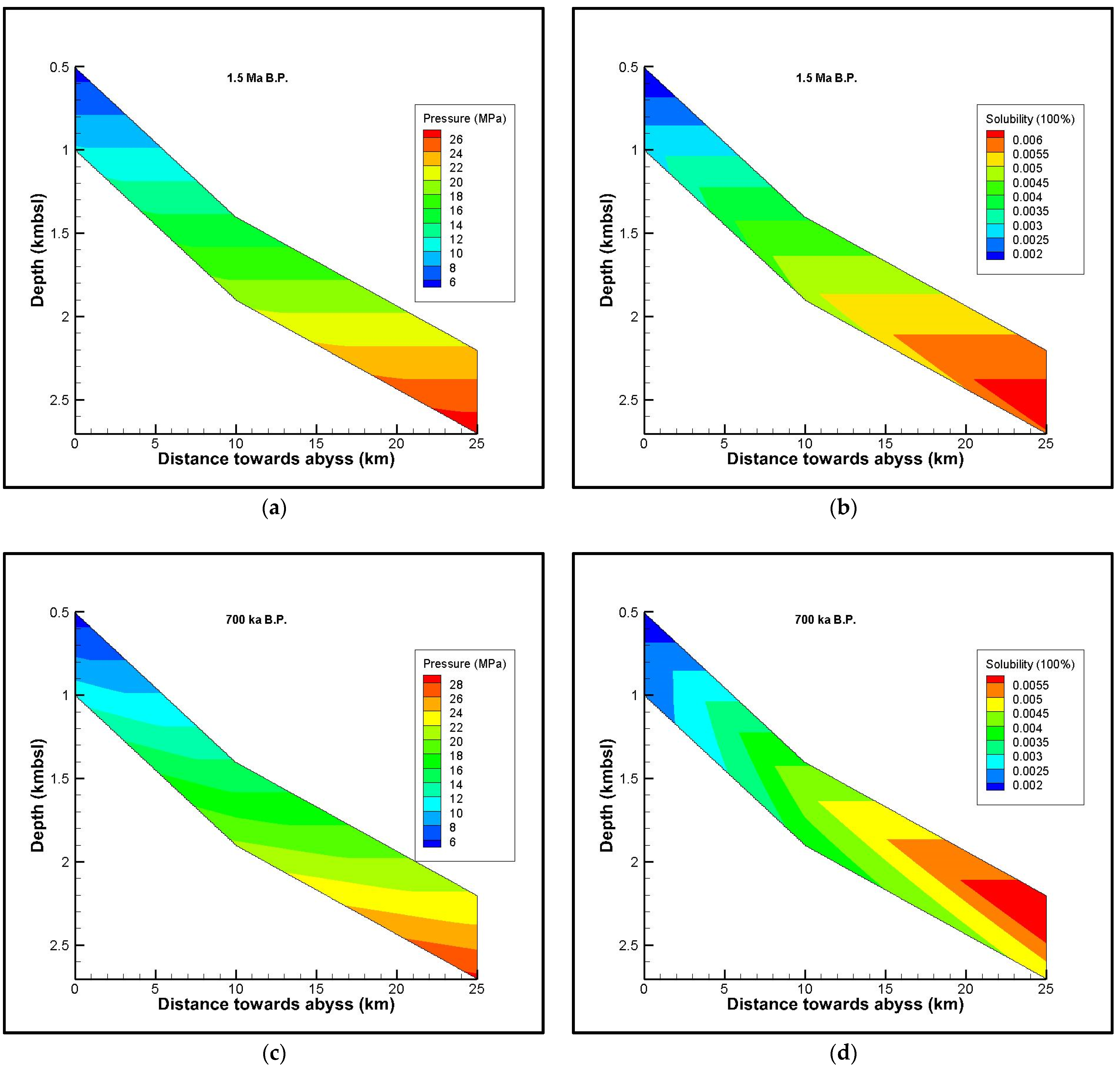

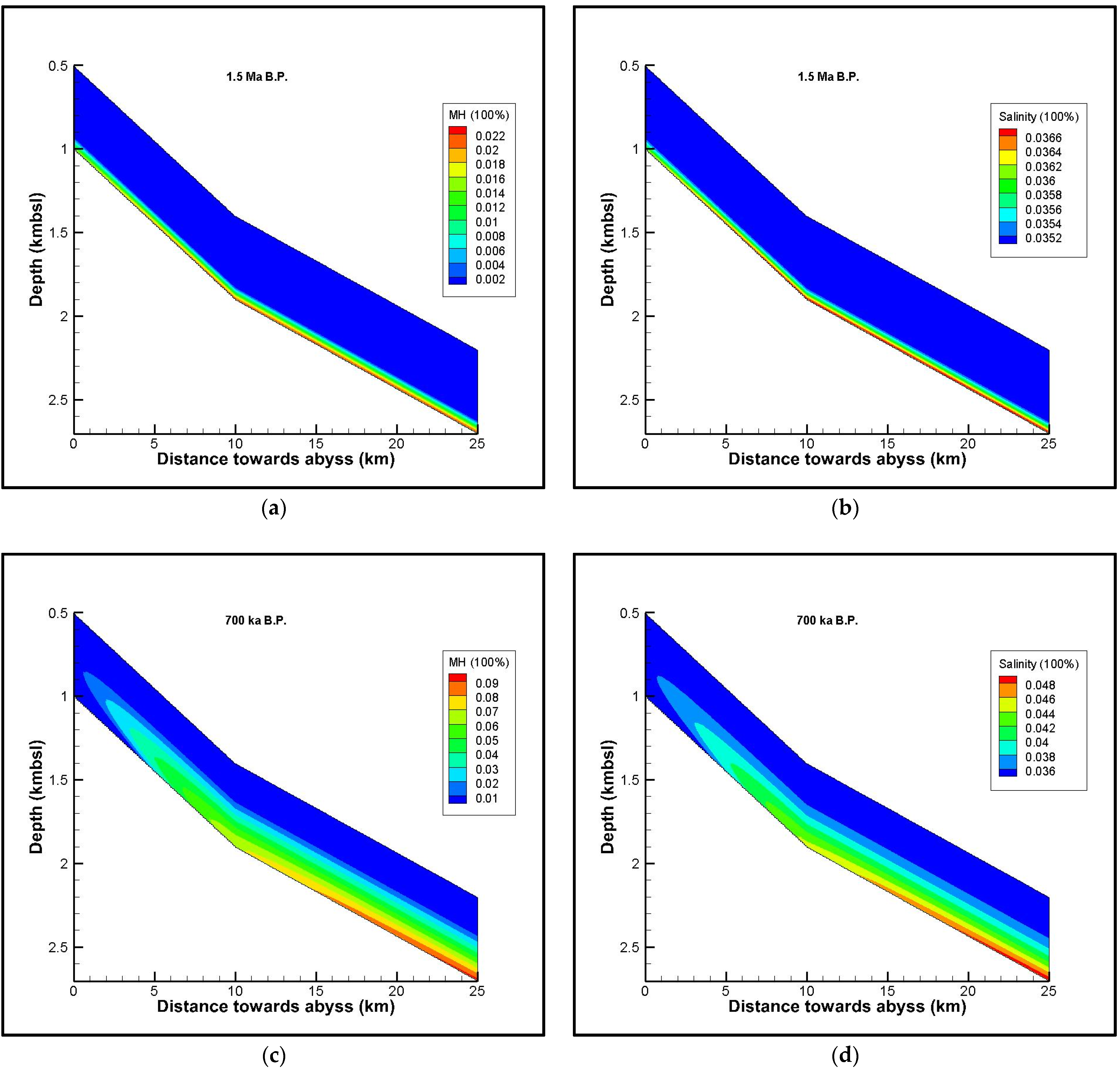

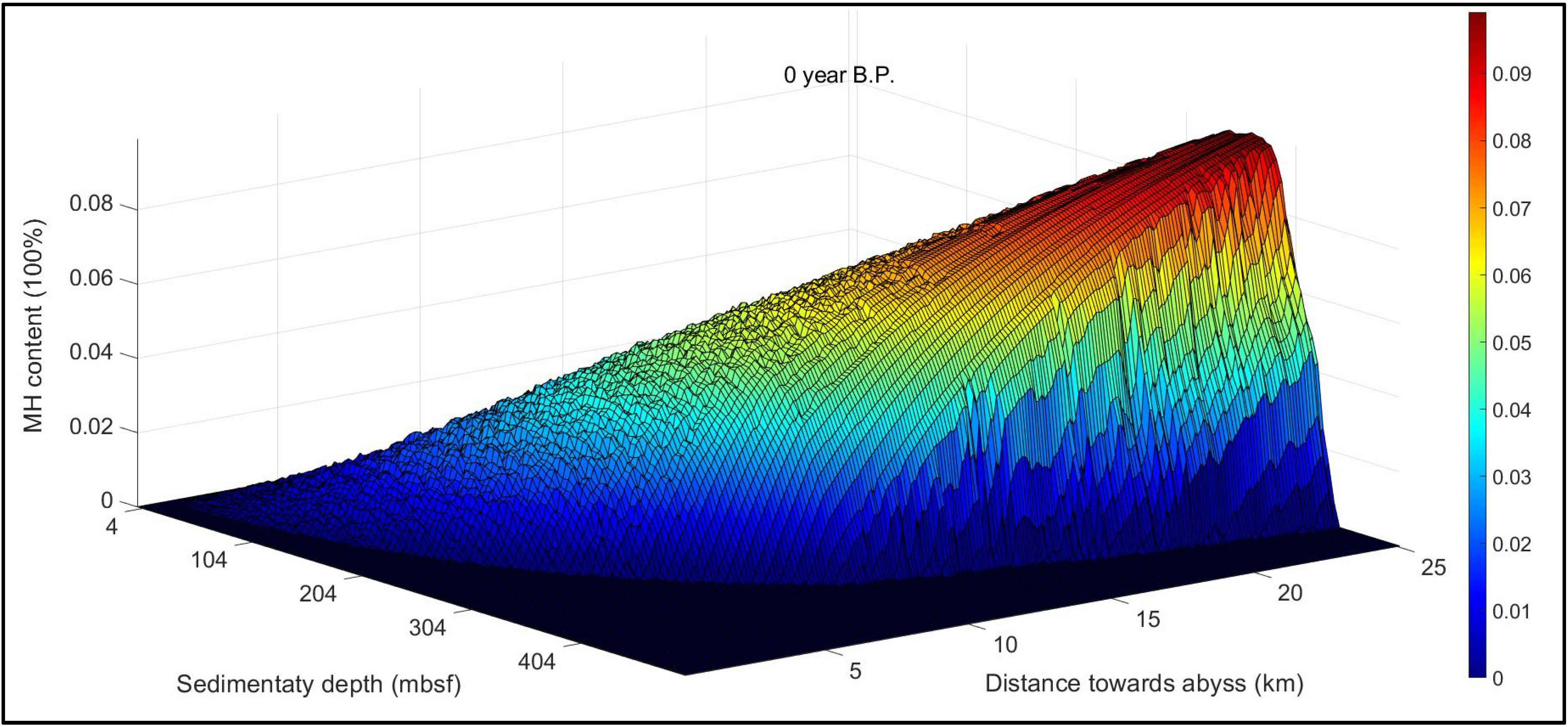

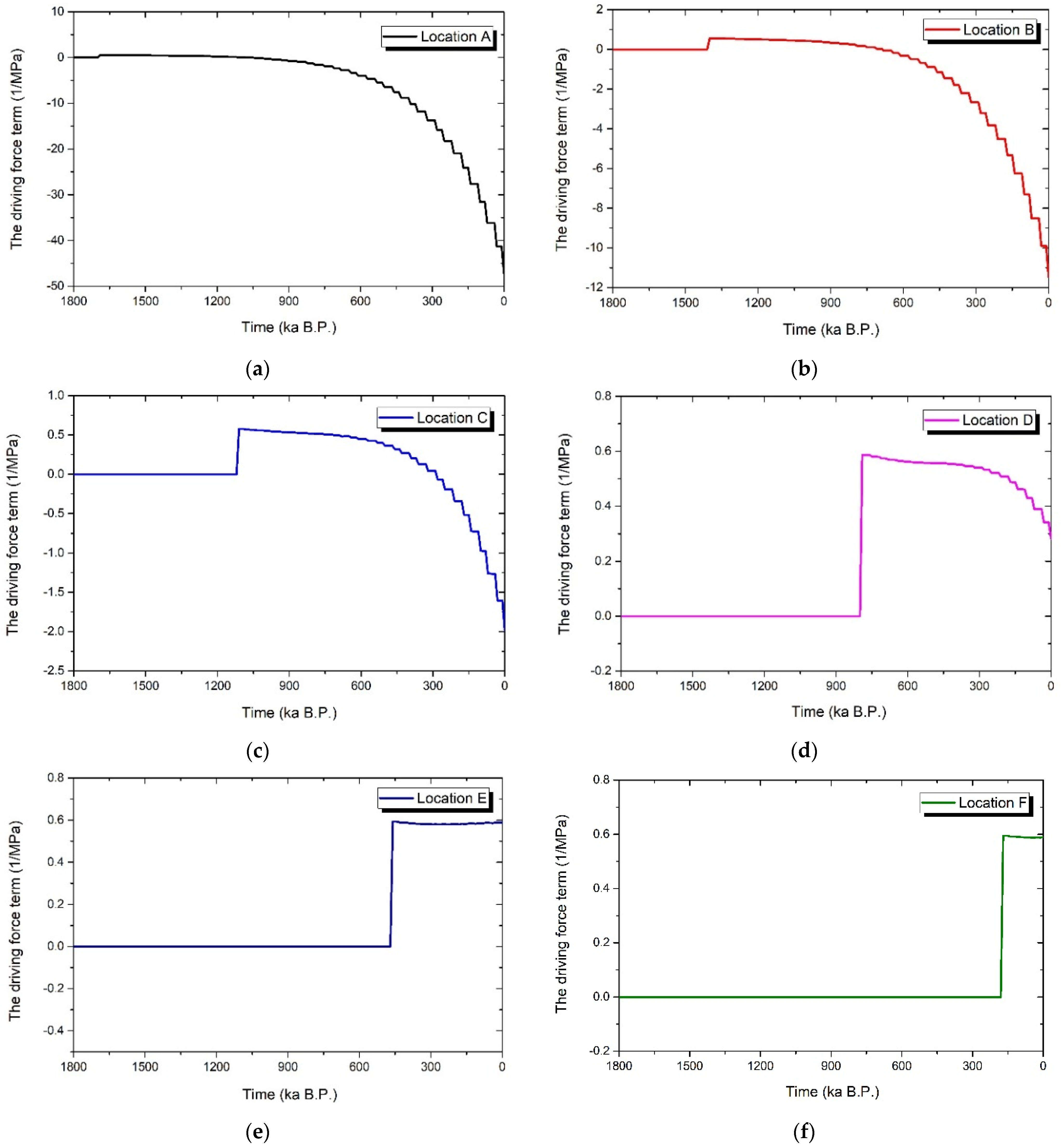
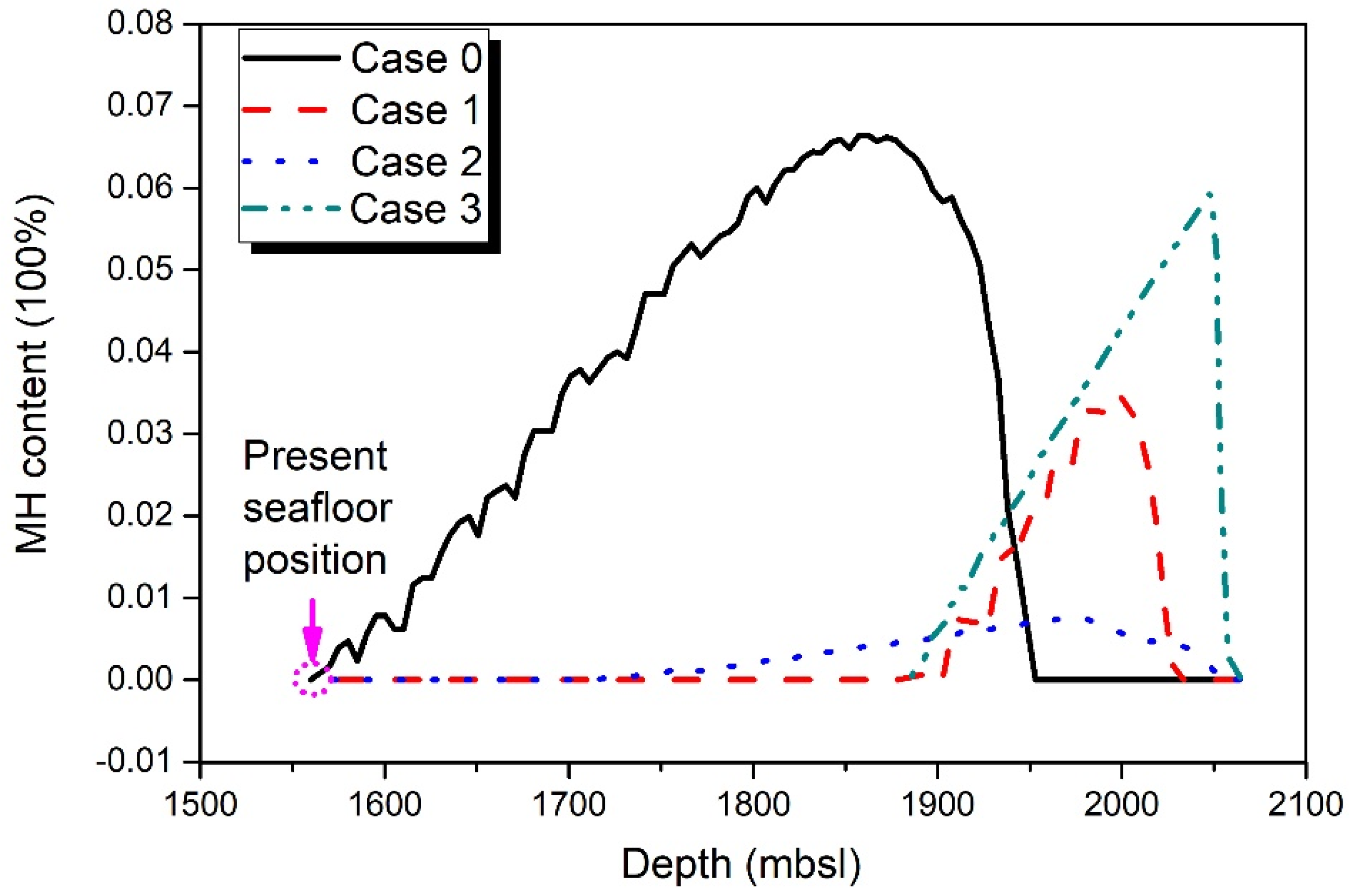
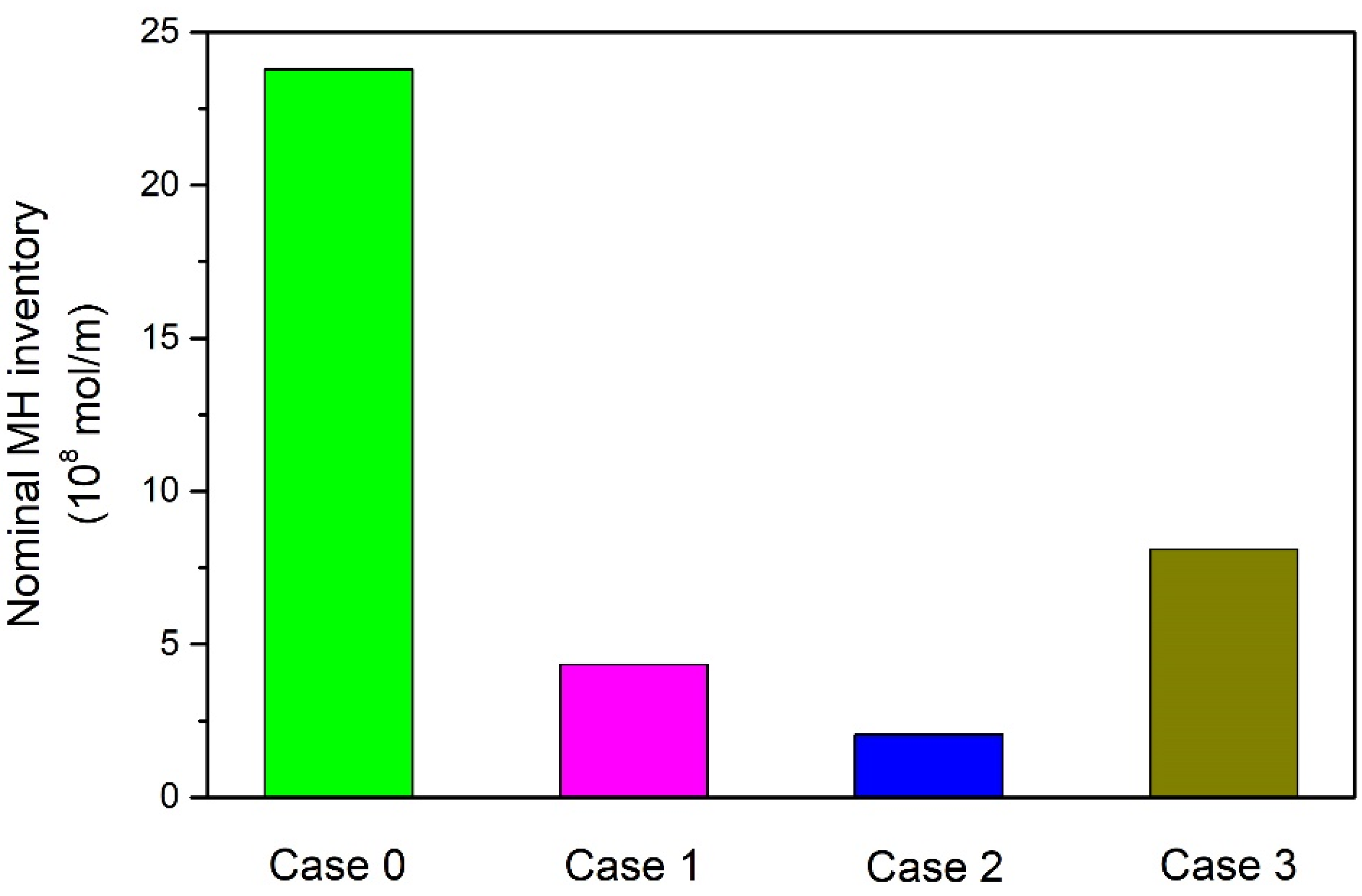
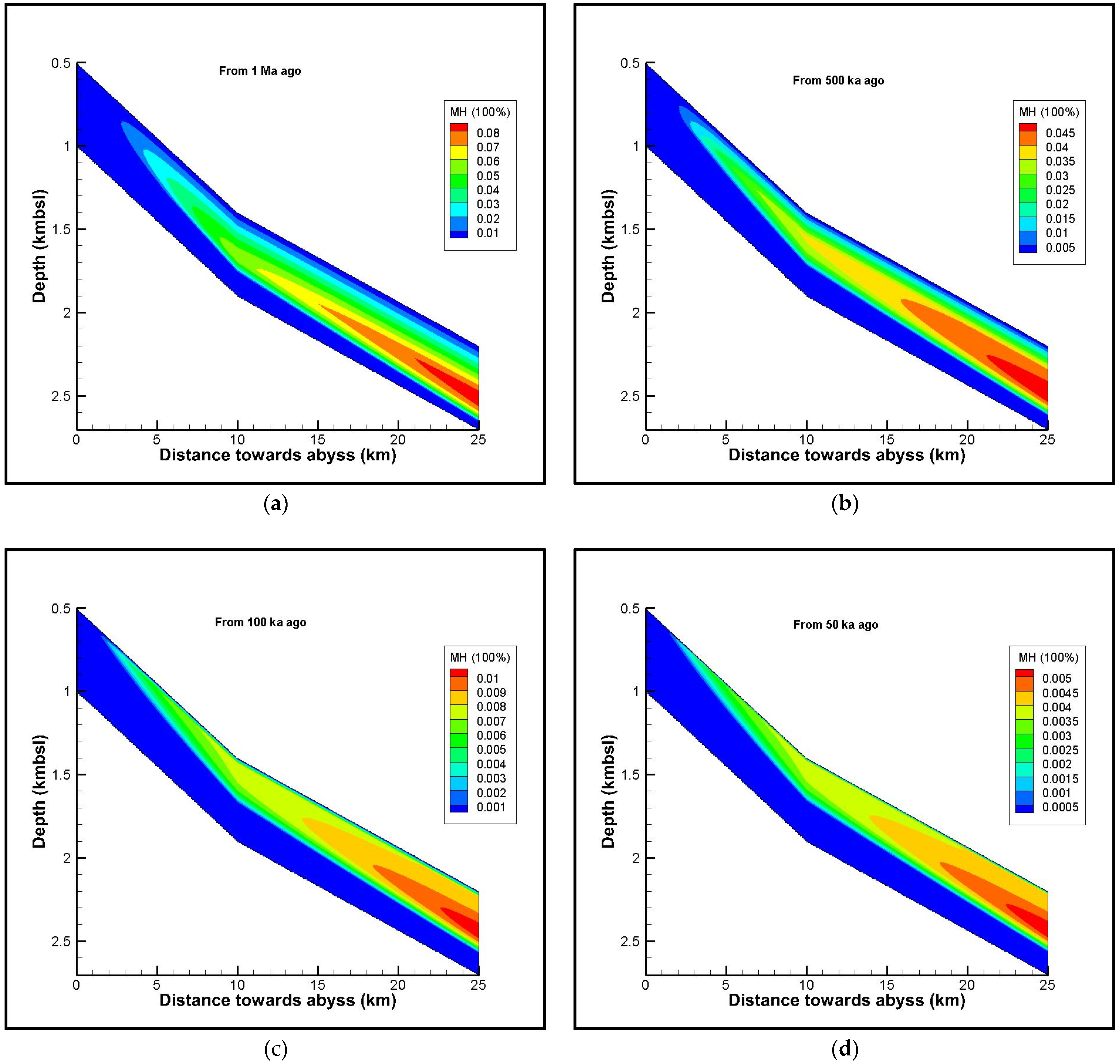
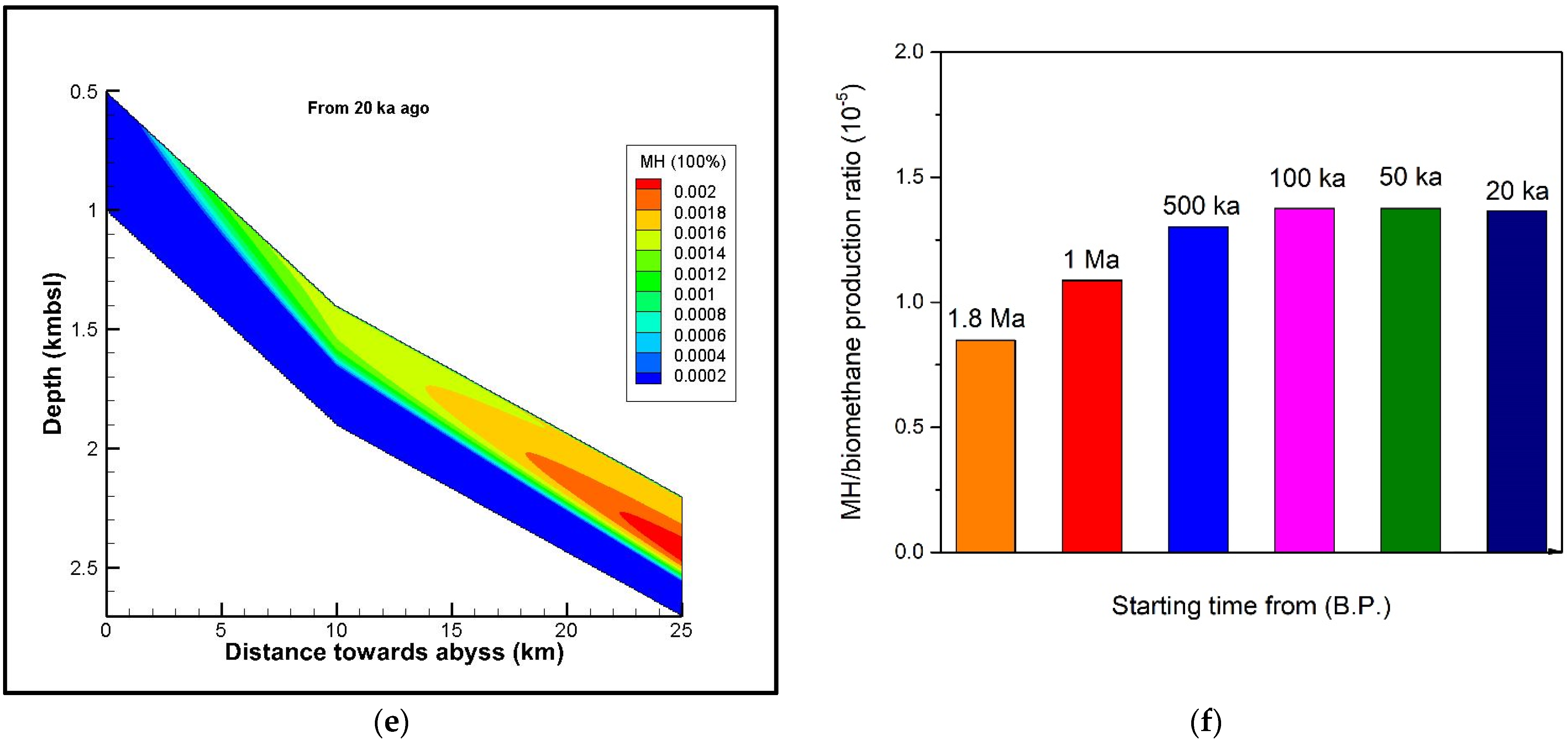

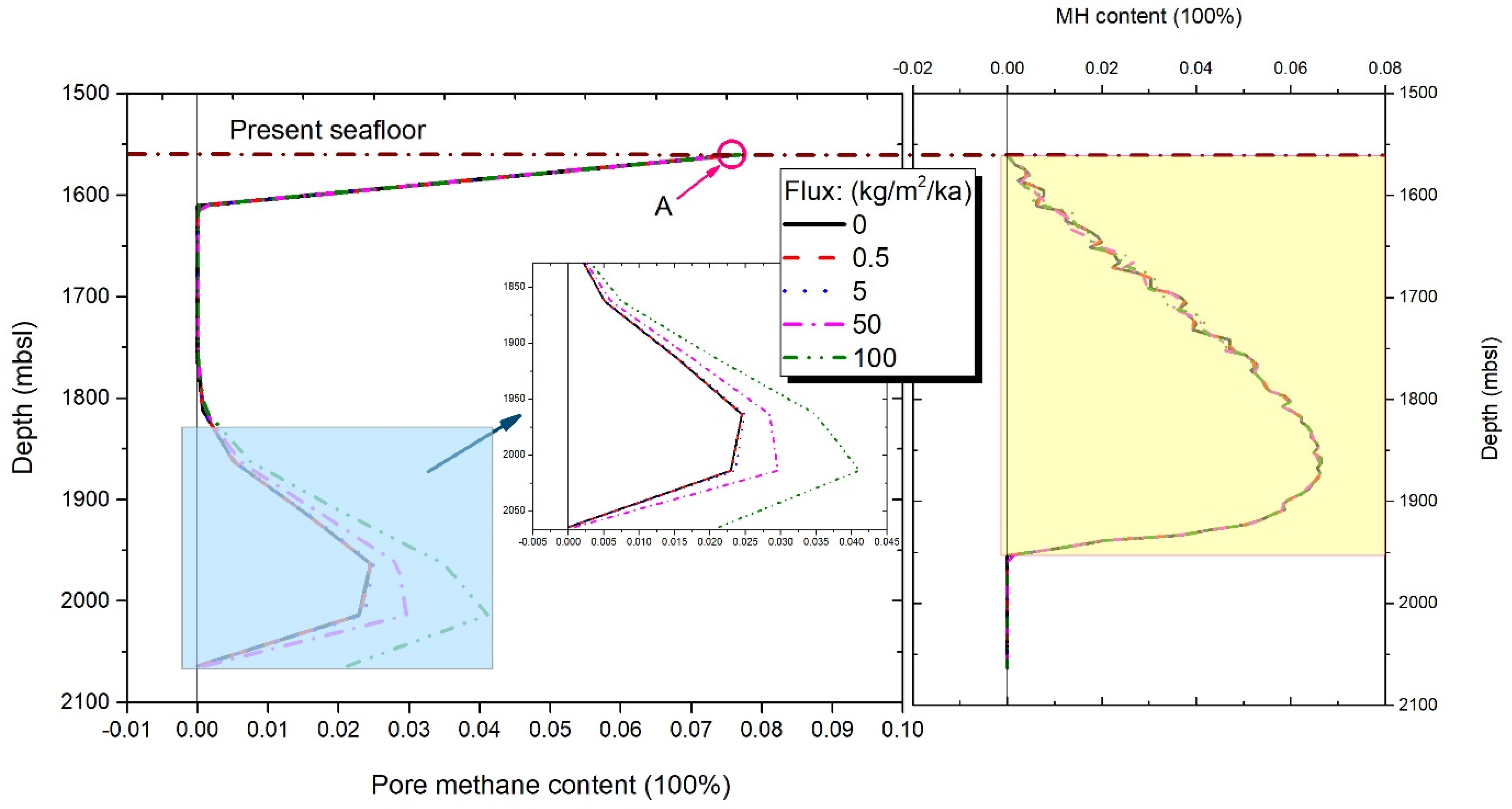
| Slope Geological Case | Sedimentary Rate (cm/ka) | Rate Constant of Microbial Gas (1/s) | Concentration of Total Labile Organic Carbon (Dry Weight %) | Depth of SRZ Bottom (mbsf) | Coefficient of MH Reaction (mol·m−3·MPa−1·ka−1) | Geothermal Gradient (°C/km) |
|---|---|---|---|---|---|---|
| Case 0 | 28 | 10−13 | 0.6 | 10 | 1 | 55 |
| Case 1 | 80 | 10−12 | 1.1 | 6 | 1 | 70 |
| Case 2 | 40 | 0.5 × 10−12 | 1.8 | 12 | 0.1 | 40 |
| Case 3 | 10 | 0.2 × 10−12 | 0.2 | 30 | 0.5 | 50 |
| Parameters | Values |
|---|---|
| Slope horizontal distance: total, first, second | 25, 10, 15 (km) |
| Slope seafloor position: crest, middle, foot | 500, 1400, 2200 (mbsl) |
| Slope deposition thickness | 504 (m) |
| Total evolution time | 1.8 (Ma) |
| Density (kg/m3): ρs, ρw, ρa0, ρh, | 2650, 1025, 0.7 (STP), 912 |
| Porosity: ϕ0,0, ϕ0,∞ | 0.68, 0.31 |
| Attenuation coefficient: β | 0.12 |
| Fraction of clay particle volume: xc | 0.3 |
| Volumetric content: θws, θwr, θar | 1, 0.08, 0 |
| SWCC coefficients: α, ϖ | 1/6.11 (1/MPa), 1.332 |
| Molar mass: Mw, Mm, Mh | 18, 16, 124 (g/mol) |
| Initial salinity: | 0.035 |
| Diffusivity: Dw(Θ), Da(Θ) | 3.3 × 10−7, 2.2 × 10−9 (m2/s) |
Publisher’s Note: MDPI stays neutral with regard to jurisdictional claims in published maps and institutional affiliations. |
© 2022 by the authors. Licensee MDPI, Basel, Switzerland. This article is an open access article distributed under the terms and conditions of the Creative Commons Attribution (CC BY) license (https://creativecommons.org/licenses/by/4.0/).
Share and Cite
Guan, J.; Liang, Y.; Wang, S.; Wan, L.; Fan, S.; Su, P.; Zhang, W.; Liang, D. New Insight on the Stratigraphic-Diffusive Gas Hydrate System since the Pleistocene in the Dongsha Area of the Northeastern South China Sea. J. Mar. Sci. Eng. 2022, 10, 434. https://doi.org/10.3390/jmse10030434
Guan J, Liang Y, Wang S, Wan L, Fan S, Su P, Zhang W, Liang D. New Insight on the Stratigraphic-Diffusive Gas Hydrate System since the Pleistocene in the Dongsha Area of the Northeastern South China Sea. Journal of Marine Science and Engineering. 2022; 10(3):434. https://doi.org/10.3390/jmse10030434
Chicago/Turabian StyleGuan, Jinan, Yian Liang, Shujia Wang, Lihua Wan, Shuanshi Fan, Pibo Su, Wei Zhang, and Deqing Liang. 2022. "New Insight on the Stratigraphic-Diffusive Gas Hydrate System since the Pleistocene in the Dongsha Area of the Northeastern South China Sea" Journal of Marine Science and Engineering 10, no. 3: 434. https://doi.org/10.3390/jmse10030434
APA StyleGuan, J., Liang, Y., Wang, S., Wan, L., Fan, S., Su, P., Zhang, W., & Liang, D. (2022). New Insight on the Stratigraphic-Diffusive Gas Hydrate System since the Pleistocene in the Dongsha Area of the Northeastern South China Sea. Journal of Marine Science and Engineering, 10(3), 434. https://doi.org/10.3390/jmse10030434









